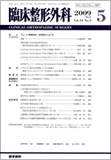Japanese
English
- 有料閲覧
- Abstract 文献概要
- 1ページ目 Look Inside
- 参考文献 Reference
頚髄症の簡便検査法である10秒テストが身体機能と関連するかについて,高齢健常者を対象に調査した.対象は地域住民検診に参加した961名のうち,60歳以上で脳疾患,関節リウマチ,脊椎手術の既往例を除外した506名である.身体機能検査は,開眼片足立ち,長座体前屈,棒反応と握力を測定した.健常者全体の10秒テストの平均値は20.6±4.4回であり,年齢とは弱い負の相関を示した.10秒テストと各身体機能の関連では棒反応のみが弱い相関を示し,その他の運動機能とは相関していなかった.今回の結果から,加齢による身体能力の低下が10秒テストの回数に与える影響は少なく,その回数自体の低下は頚髄症患者で著明であることから,健常者においても神経伝導障害の影響を強く受けている可能性が考えられた.
The relation between the results of the grip-and-release test, which is a convenient method for evaluating myelopathy, and the physical functions of healthy aged people was investigated. Data was collected from 961 local residents, but only the data from people over 60 years of age were analyzed. The data from people with brain disorders rheumatism, who had undergone spinal surgery, etc. were also excluded, and ultimately the data from 506 healthy subjects were analyzed. The physical functions tested were one-leg standing, sitting trunk flexion, stick catching, and grip strength. The average grip-and-release test value of the subjects as a whole was 20.6±4.4, and a weak negative correlation was found between the grip-and-release test values and age. Only the results of the stick catching test were correlated with the results of the grip-and-release test. The correlation was weak but grew stronger with age, especially at 70 years of age and over. Thus, there were no strong correlations between the results of the grip-and-release test and the results of the physical function tests in healthy aged people. The lower grip-and-release test values may be attributable to the influence of nerve conduction caused by brain disorder or myelopathy, etc.

Copyright © 2009, Igaku-Shoin Ltd. All rights reserved.


